Intel Core i7 4960X (Ivy Bridge E) Review
by Anand Lal Shimpi on September 3, 2013 4:10 AM EST- Posted in
- CPUs
- Intel
- Ivy Bridge
- Ivy Bridge-E
Visual Studio Compile
Our compile test is back and better than ever. With a much larger and faster SSD (Samsung SSD 830, 512GB), we're able to get more consistent compile times between runs. We're now using Visual Studio 2012 to compile Mozilla's Firefox project. The compile is multithreaded however there are periods of serial operation where performance is bound by the speed of a single core. The end result is a benchmark that stresses both single and multithreaded performance. Compile times are reported in minutes elapsed.
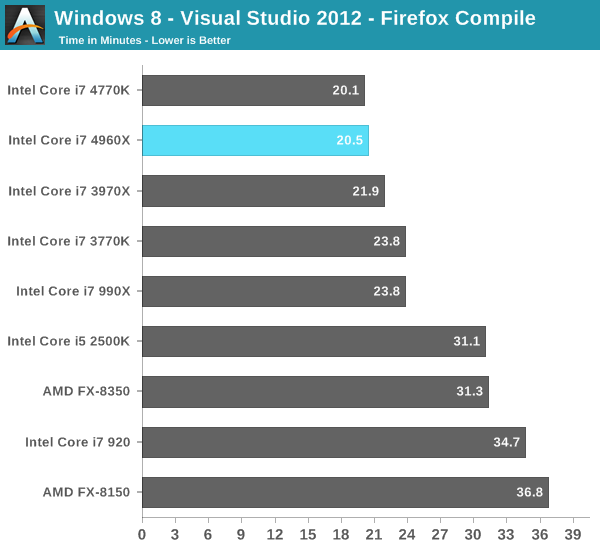
It's clear that IVB-E holds the advantage over Haswell when faced with heavily threaded workloads, but what about those workloads that are a good mix of both light and heavily threaded tasks? A medium-threaded workload if you will. It turns out our Firefox compile test is just that. Haswell's architectural improvements seem to do wonders for this test (under OS X as well), giving the 4770K a 16% lower compile time than Ivy Bridge. IVB-E on the other hand throws more cores at the problem, effectively equaling Haswell's performance but not exceeding it. In this case, if the rest of your applications are better threaded/demand more cores then IVB-E is the right solution for you. If, however, building Visual Studio projects is the most thread heavy thing you do then Haswell is a better option.
Photoshop
To measure performance under Photoshop CS4 we turn to the Retouch Artists’ Speed Test. The test does basic photo editing; there are a couple of color space conversions, many layer creations, color curve adjustment, image and canvas size adjustment, unsharp mask, and finally a gaussian blur performed on the entire image.
Time is reported in seconds and the lower numbers mean better performance. The test is multithreaded.
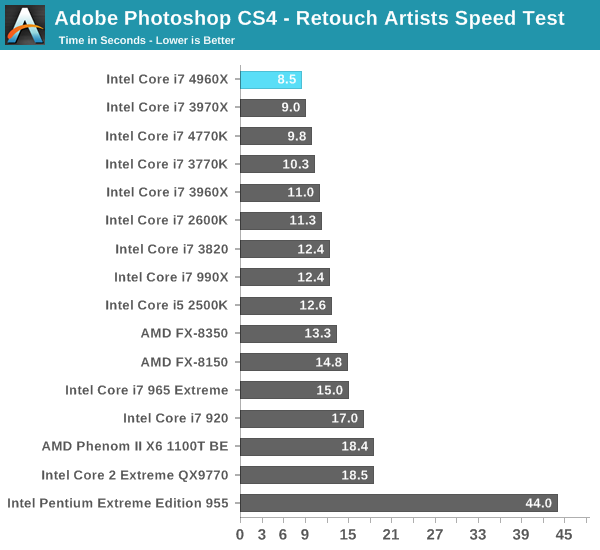
Our Photoshop test provides another example of an application with both lightly and heavily threaded behaviors. In this case, our Photoshop test favors the latter as the 4960X manages a 13% performance advantage over the 4770K. Once again the IVB-E advantage over SNB-E is around 5%.
File Compression/Decompression
The 7-zip benchmark is a CPU bound multithreaded integer workload that looks at 7-zip compression/decompression algorithms where the IO subsystem is removed from the equation:
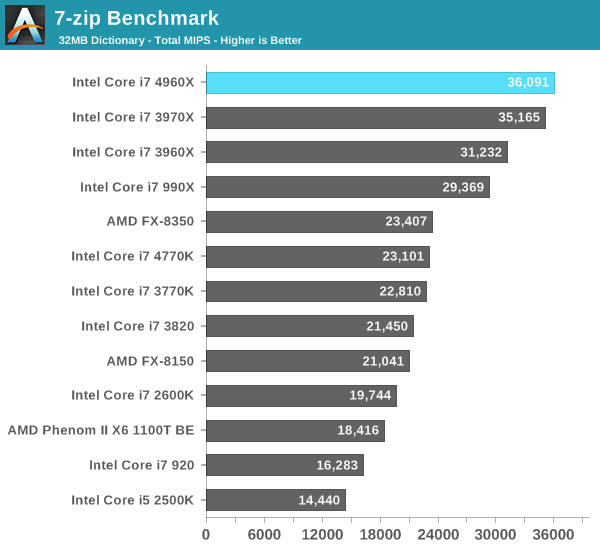
In its biggest advantage so far, the 4960X outperforms the 4770K by 56% in the 7-zip test. The IVB-E performance advantage compared to SNB-E shrinks to under 3% here. Heavily threaded integer workloads are also well suited for AMD's FX architecture. Here the FX-8350 is able to equal Haswell's performance.
Next up is our old Par2 test. Par2 is an application used for reconstructing downloaded archives. It can generate parity data from a given archive and later use it to recover the archive. Chuchusoft took the source code of par2cmdline 0.4 and parallelized it using Intel’s Threading Building Blocks 2.1. The result is a version of par2cmdline that can spawn multiple threads to repair par2 archives. For this test we took a 708MB archive, corrupted nearly 60MB of it, and used the multithreaded par2cmdline to recover it. The scores reported are the repair and recover time in seconds.
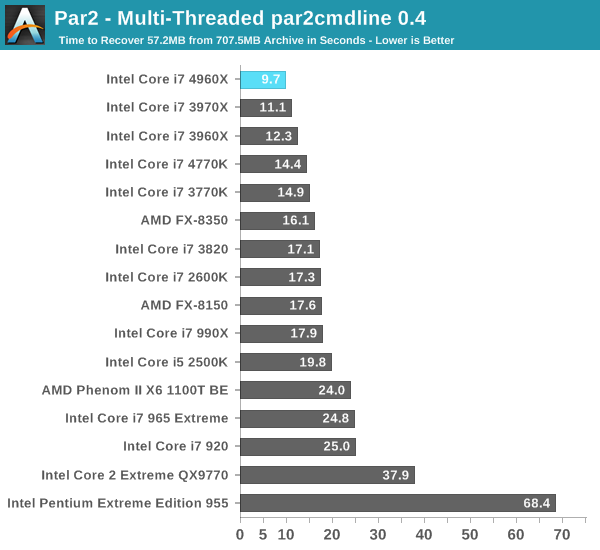
Here's another heavily threaded workload that does very well on the 4960X. We also see a rare situation where IVB-E increases performance over SNB-E by more than 10%.
Excel - Heavy Math
In our final CPU centric test we're running a monte carlo simulation on a large Excel spreadsheet. The process is well threaded.
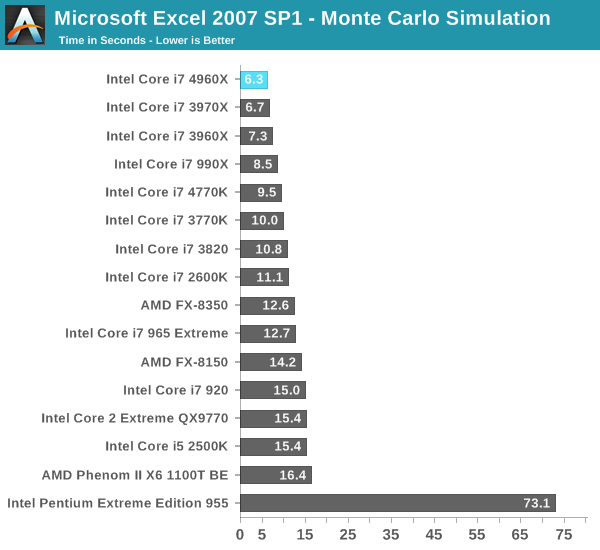
With 50% more cores, the 4960X delivers 33% better performance than the 4770K. If running multithreaded math workloads is up your alley, there's no alternative to the 6-core extreme edition parts.










120 Comments
View All Comments
cactusdog - Tuesday, September 3, 2013 - link
IB-E is a massive failure just like SB-E. Thanks Intel for killing the highend for me. Actually, I think this is their plan, to kill the highend. Its ridiculous that this platform is so far behind the mainstream platform. 2x sata 6GB/s ports? No Intel USB 3.0? Worse Single threaded performance than mainstream? Sandy Bridge-e seemed like an unfinished project where many compromises were made and ivy-e looks the same.knweiss - Tuesday, September 3, 2013 - link
Anand, you write that Corsair supplied 4x 8GB DDR3-1866 Vengeance Pro memory for the testbed. However, you also remark "infrequent instability at stock voltages" with 32 GB. Then, in the legend of memory latency chart, you write "Core i7-4960X (DDR3-1600)" .So I wonder which memory configuration was actually used during the benchmarks? Less than 32 GB with DDR3-1866, non-stock voltages, or 32GB DDR3-1600? Wouldn't anything but 4x DDR3-1866 be a little bit unfair because you otherwise don't utilise the full potential of the CPU?
bobbozzo - Tuesday, September 3, 2013 - link
The article says that 1600 is the max memory speed SUPPORTED if you use more than one DIMM per channel.knweiss - Wednesday, September 4, 2013 - link
There are 4 channels.chizow - Tuesday, September 3, 2013 - link
Nice job Anand, your conclusion pretty much nailed it as to why LGA2011 doesn't cut it today and why this release is pretty ho-hum in general. I would've liked to have seen some 4820K results in there to better illustrate the difference between 4770K Haswell and SB-E, but I suppose that is limited by what review samples you received.But yeah, unless you need the 2 extra cores or need double DIMM capacity, there's not much reason to go LGA2011/IVB-E over Haswell at this point. Even the PCIe lane benefit is hit or miss for Nvidia users, as PCIe 3.0 is not officially supported for Nvidia cards and their reg hack is hit or miss on some boards still.
The downsides of LGA2011 vs LGA1150 are much greater, imo, as you lose 4 extra SATA3(6G) ports and native USB 3.0 as you covered, along with much lower overall platform power consumption. The SATA3 situation is probably the worst though, as 2 isn't really enough to do much, but 6 opens up the possibility of an SSD boot drive along with a few really fast SATA3 RAID0 arrays.
TEAMSWITCHER - Tuesday, September 3, 2013 - link
I'm really disappointed by these numbers. As a software developer, the FireFox compile benchmark best indicates the benefit I would get from upgrading to this CPU. And, it looks like the 4770K would be about the same difference - except far less expensive. I really don't think I need anything more than 16GB for RAM, and one high-end graphics card is enough to drive my single WQHD (2560x1440) display. Do bragging rights count? No...I mean really?madmilk - Tuesday, September 3, 2013 - link
Time to consider Xeons...MrBungle123 - Tuesday, September 3, 2013 - link
What's a Xeon going to do? Be slower than the 4960X? You lose clock speed by going with huge core counts and that translates to even more losses in single threaded performance. There comes a point where there are diminishing returns on adding more cores... (see AMD)MrSpadge - Tuesday, September 3, 2013 - link
Time to save yourself some money with a 4770 - not the worst news.Kevin G - Wednesday, September 4, 2013 - link
Your best bet would be to hope for desktop CrystalWell part. That extra cache should do wonders for compile times even if you'd lose a bit of clock speed. However, Intel is intentionally holding back the best socket 1150 parts they could offer as the benefits of Crystalwell + TSX optimized software would put performance into large core count Xeon territory in some cases.